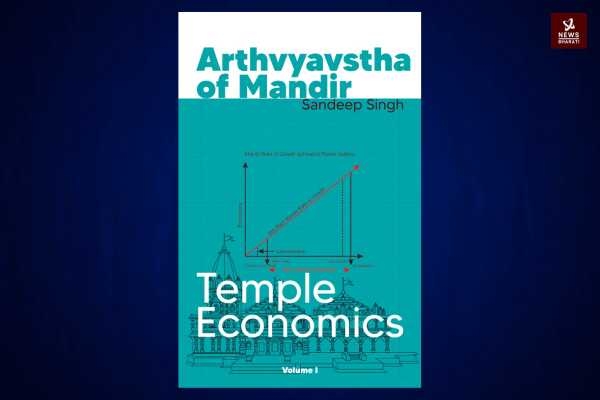Arthvyavstha of Mandir (Temple Economics) by Sandeep Singh
The book, ‘Arthavyavstha of Mandirs’ by Sandeep Singh is an attempt to document the journey of brainwashing of Hindu minds against their own temples and importance of ‘Temple Economics’ in Bharat and the way forward. The book explains traces of the antiquity, ebb and flow of Temple Economics.
Total Views |
- The book review is written by Dr (Prof) Poornima Tapas, Symbiosis Institute of Business Management, Pune
The demolition, disrespect and loot of temples is a millennial old phenomenon that has wounded Bharat in multiple ways. It has a devastating impact on psyche and socio-economic conditions of Hindus. This did not stop even after independence in 1947. Hindus are still struggling to free their temples from the clutches of so-called secular government.

The book, ‘Arthavyavstha of Mandirs’ by Sandeep Singh is an attempt to document the journey of brainwashing of Hindu minds against their own temples and importance of ‘Temple Economics’ in Bharat and the way forward. The book explains traces of the antiquity, ebb and flow of Temple Economics.
There are four parts/sections in the book:
Part I: Arthashastra of Mandir (Temple Economics)
Part II: Destruction of Mandir and its Arthavyavstha (Destruction of Temple Economics)
Part III: Loss of Mandir Ecosystem, Post-Independence
Part IV: Need to re-establish Mandir Ecosystem
Strength of the book is that it gives examples of various Mandirs spread across Bharat, their story of construction and destruction and their contribution in lives of people. Author urges that it is high time that we move ahead of talking, writing and reading about problems of Mandir. It is the time for action. The book has many interesting case studies reflecting how pilgrimages have an impressive economic dimension which brings prosperity not only to Dharma but to the nation.
The author’s style of writing is unique in the sense that the names of Devi, Devtas are written in the original (Hindu) way. For example, Dharma is written as Dharm, Rama is written as Ram and so on. Use of word Mandir (instead of Temple), Arthavyavstha (instead of Economics) is very significant! There is a vast difference between Economics and Arthavyavstha. Economics only analyses production, distribution and consumption of goods and services and is not concerned with the ethical, moral, philosophical and spiritual values which Mandir signifies. He further explains that the Temple is the place of worship, whereas Mandir is the abode of Bhagwan. Mandirs are consecrated according to the shastras by application of different proportionate measurement and standards. The Mandir Sanskriti in Bharat is intimately interwoven with the life of people, both as individual and society at large.
The author has beautifully shown the correlation between Mandir and Arthavyavstha. Readers would be awestruck to read about the financial, economic and scientific benefits of Mandirs. The book also describes how mandir based arthavyavastha was destroyed in an organized manner and on a large scale by Islamic and Christian invaders.
Consistent attacks on the Mandirs and the spirited come back by our ancestors leaves one with the mixed feelings. There is not even an iota of doubt that with the gradual shift in the awareness about Mandirs, the wealth,
intelligence and technology that Hindus have at their disposal, the revival of mandir and various aspects associated with it will see an exponential growth. A small, smart and focused approach from each Hindu irrespective of the class, caste, region or language can contribute for increasing number of Mandirs and the activities run by Mandirs such as schools, hospitals etc. Mandirs have significant employment generation potential. They can employ people in various services such as hospitality, maintenance, security, arts and crafts, and agriculture. These activities provide opportunities for skilled and unskilled workers and contribute to the local economy -- contribution of Mandir Arthavyavstha in the 21st century from Bharat to the world is not a question anymore!
The author took four years to complete this book -- it is all worth it! He has written about Mandirs in such a great detail that the reader can know everything about the Mandirs just by reading this book.
This book will help the current and future generations to look at the Mandir from a new perspective. It provides great insights into the Temple-based economy. There are lot of tables in the book to provide a comprehensive picture of the various aspects related to Mandirs. Addition of a few more pictures in the book would have made it easy on the eyes and good for retention of information.
Mumbai University is planning to start a course on Temple Management - this book will be of great help!
The second volume, ‘A Decade for Mandirs’ which talks about expectations from devotees for the betterment of temples. How does one restore Mandirs back to their glory of the past – it is a question each Hindu must understand.
To buy the book one can get in touch with the author on templeeconomics@gmail.com

